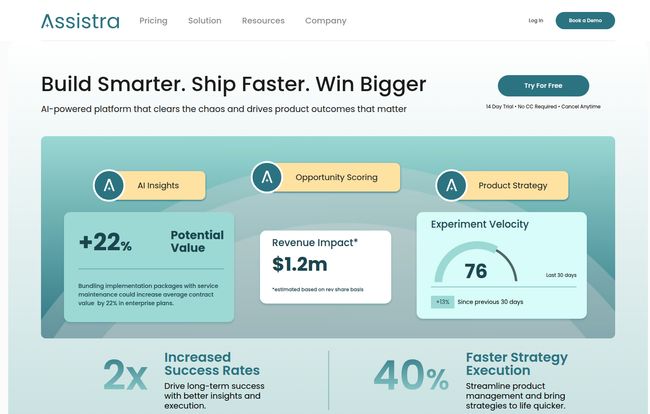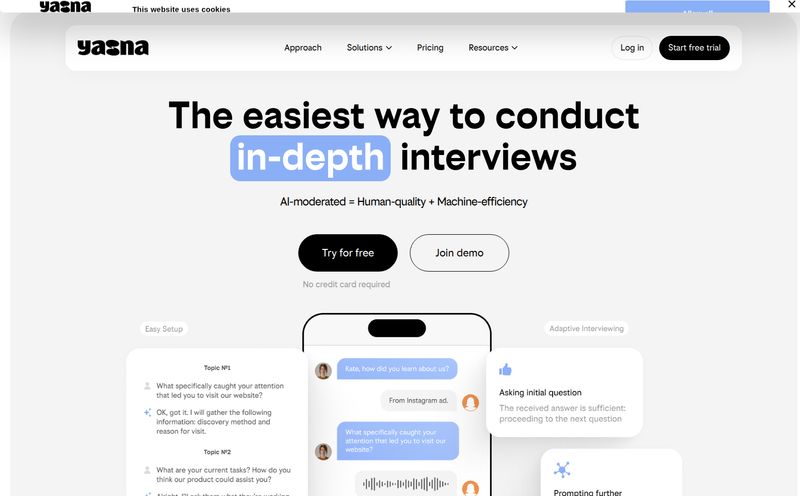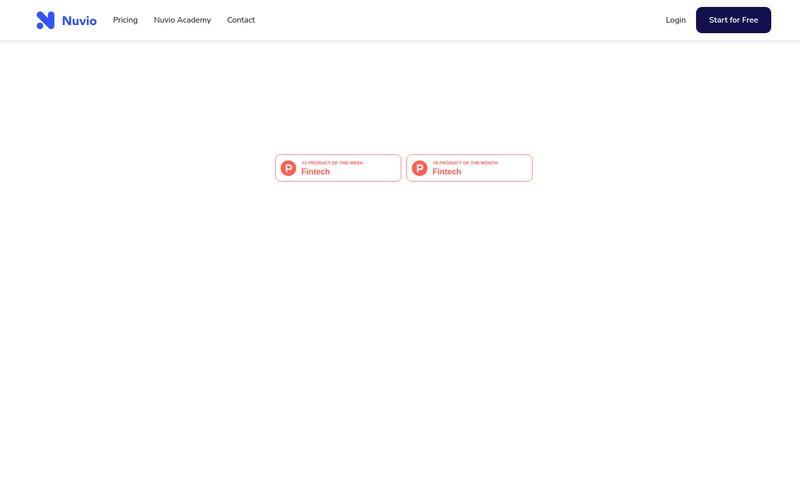If you're in the product world, you know the chaos. It's a constant juggling act of stakeholder demands, endless spreadsheets of user feedback, and the looming pressure to just... ship faster. We've all been in those meetings where strategy feels a million miles away from the daily grind of writing tickets. It’s exhausting.
So, when a tool like Assistra pops up on my radar, flashing big promises like "Build Smarter. Ship Faster. Win Bigger," my inner cynic and my hopeful innovator have a little argument. The cynic scoffs, "Another buzzword-laden platform," while the innovator whispers, "But what if this is it? What if this actually works?"
I've spent years sifting through the digital noise, separating the game-changers from the wannabes. Today, I'm putting Assistra under the microscope. We're going to look past the slick marketing and see if it's truly the AI-powered co-pilot for product teams that it claims to be.

Visit Prodhubai
So, What is Assistra, Really?
At its core, Assistra is an AI-powered platform designed to bring some sanity to the beautiful madness of product management. It's not trying to replace the product manager—let's get that straight. Instead, it positions itself as an intelligent assistant, an ally that automates the soul-crushing grunt work so you can focus on the big picture.
Think of it as the connective tissue between the three critical pillars of product development: your high-level strategic goals (the 'why'), your mountain of raw customer feedback (the 'what'), and your team's execution engine (the 'how'). It aims to weave these disparate threads into a coherent story, driven by data instead of just gut feelings.
The Core Features That Actually Matter
A tool is only as good as its features, right? I've seen a lot of platforms with flashy dashboards that don't actually solve a problem. Assistra seems to have honed in on some of the biggest time-sinks for PMs.
From Messy Feedback to Crystal-Clear Insights
This one got my attention immediately. We've all been there: exporting NPS survey results into one sheet, copying and pasting notes from customer calls into another, and trying to find themes in a sea of support tickets. It's a manual, error-prone process that can take days.
Assistra claims to ingest all of this qualitative data—from sales calls to user interviews—and use AI to find the signal in the noise. The dashboard shows it analyzing thousands of pieces of feedback to pinpoint recurring issues, rank them by urgency, and even tie them to specific product areas. This is the kind of stuff that turns a vague complaint like "the app is confusing" into an actionable insight like "Users on iOS 17 are struggling with the new reporting export feature." That's not just helpful; it's a quantum leap in efficiency.
Instant PRDs and User Stories? Yes, Please.
Okay, the generative AI part. This is where things get really interesting. Once you have an insight or an idea, the next step is translating it into something your engineering team can actually build. Writing detailed Product Requirements Documents (PRDs), epics, and user stories is a craft, but it's also incredibly time-consuming.
Assistra seems to automate a huge chunk of this. The interface shows it turning a simple idea into a structured document, complete with user stories like, "As a parent, I want to be able to transfer money to my child's college or university, so that I can easily pay." David Lusky from Google even mentioned its ability to handle the "routine aspects of Product Managment work." If the AI can produce a solid first draft of all my user stories, that frees up hours for me to focus on strategy, user research, and talking to my team. It’s like having a junior PM who never sleeps or asks for a day off.
Connecting Your Work to Actual Business Goals
Here’s the thing that separates a good PM from a great one: tying your work directly to business outcomes. It's easy to get lost in the weeds of feature development and forget why you're building it. Assistra seems to tackle this head-on with a goal-setting and tracking feature.
You can define high-level objectives like "Increase ARR by 4x" or "Improve customer retention by 15%." The platform then helps you link your product initiatives and experiments directly to these goals. This creates a clear line of sight from a single user story all the way up to the company's bottom line. For any PM who's had to justify their roadmap to leadership, this is gold. It changes the conversation from "We're building this feature" to "This feature will contribute to our revenue goal in this specific way."
The Big Picture: What This Means for Your Workflow
Let's look at the numbers Assistra throws around: 40% faster strategy execution, 2X increased success rates, a $1.2M potential revenue impact. Are these just marketing fluff? Maybe. But they point to a real-world benefit. By automating the mundane and connecting the dots, a tool like this could fundamentally change a product team's velocity.
It's like giving a ship's captain a real-time, satellite-powered navigation system instead of a dusty old map and a compass. You can see the weather patterns (user feedback), plot a more direct course (strategy), and adjust on the fly to get to your destination (market success) faster and with less risk.
But Is It All Sunshine and Rainbows?
Let's be real. No tool is perfect. I have to put on my critical hat for a moment. While the potential is huge, there are a couple of things that give me pause. These aren't dealbreakers, but they are things to be aware of.
First, the classic "garbage in, garbage out" problem. The AI's insights are only as good as the quality and volume of the data you feed it. If your customer feedback is sparse or your strategic goals are poorly defined, Assistra can't magically invent clarity. It's an amplifier, not a creator.
Second, there's a subtle risk of becoming too reliant on the patterns it identifies. The AI is trained on existing data and requirements. This is fantastic for optimization and incremental improvements. But what about true, disruptive innovation? The kind of 'blue-sky' idea that no customer is asking for yet because they can't imagine it exists. Over-reliance on a tool like this could, potentially, stifle that kind of out-of-the-box thinking if you're not careful. You still need that human spark of creativity.
Who is Assistra For? (And Who Should Maybe Skip It?)
I see this being a massive win for mid-to-large product organizations and fast-growing scale-ups. Teams that are starting to feel the pain of communication silos, overwhelming feedback channels, and a disconnect between strategy and execution will get the most out of this. If you have multiple product squads and a C-suite that demands data-driven roadmaps, you should probably be booking a demo.
Who should pass? Maybe a very early-stage startup or a solo founder. If your entire team fits around one table, you probably don't have the communication overhead that Assistra is built to solve. Your feedback volume might not be high enough to really power the AI, and you can probably keep your roadmap on a simple Trello board for now.
What About the Price Tag?
Ah, the million-dollar question. Or, hopefully, not quite a million dollars. The Assistra site doesn't list its pricing publicly. In the B2B SaaS world, this is pretty standard and usually means one thing: it’s not a self-serve, credit-card-on-file kind of product. You'll likely have to talk to a sales rep and get a custom quote based on your team's size and needs. Expect enterprise-level pricing that's justified as an investment in efficiency and speed, not a casual monthly subscription.
Frequently Asked Questions About Assistra
What does Assistra do?
Assistra is an AI-powered software platform for product management. It helps teams analyze customer feedback, automate the creation of documents like PRDs and user stories, and track product initiatives against strategic business goals to speed up development.
How does Assistra use AI?
It uses AI in two main ways. First, it uses natural language processing (NLP) to analyze large volumes of qualitative data (like interviews and surveys) to identify key themes and insights. Second, it uses generative AI to help write product documentation, turning ideas into structured user stories and requirements.
Is Assistra good for small teams?
It's likely better suited for mid-to-large sized teams or scale-ups where complexity and communication overhead are significant challenges. Very small teams might not need its full power just yet.
Can Assistra write my user stories for me?
It can generate them for you based on the ideas and insights you provide. It's best thought of as a powerful tool to create a first draft, which the product manager can then refine and add context to. It's a massive time-saver.
How much does Assistra cost?
Pricing is not publicly available on their website. This typically means it's sold on a per-customer basis, and you'll need to book a demo and talk to their sales team for a quote.
Who are Assistra's main competitors?
While the space is evolving, it competes with other product management platforms like Productboard and Aha!, as well as more specialized feedback analysis tools like Dovetail. Its unique selling point is the tight integration of AI across the entire workflow, from feedback to documentation.
Final Thoughts: My Verdict on Assistra
So, is Assistra the future of product management? It's definitely a powerful glimpse of it. It’s not a magic wand that will solve all your problems, and it won't replace the critical thinking and creative vision of a good PM. But that's not the point.
What it does is act as a force multiplier. It takes the most tedious, time-consuming parts of the job and puts them on autopilot. It provides the data to back up your intuition and the tools to communicate your vision clearly. For product teams drowning in chaos, Assistra looks less like just another tool and more like a lifeline. It’s definitely a platform I’ll be keeping a close eye on.
Reference and Sources
- Assistra Official Website (Note: A placeholder link as the actual URL may vary): www.assistra.com
- On the role of AI in product management, a good overview can be found on articles from sources like ProductPlan.



